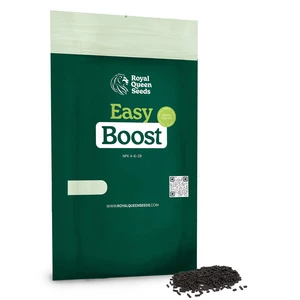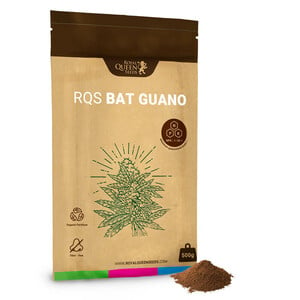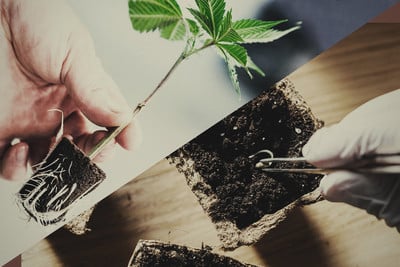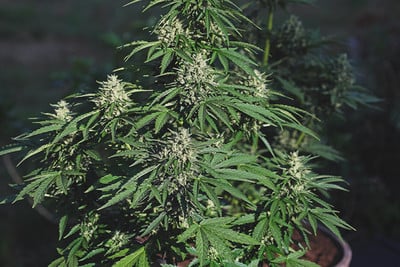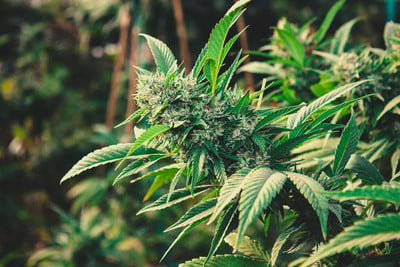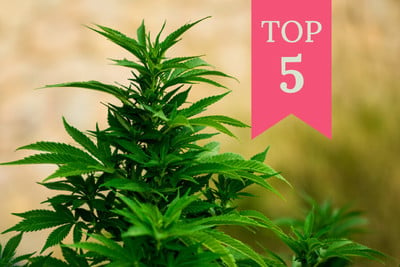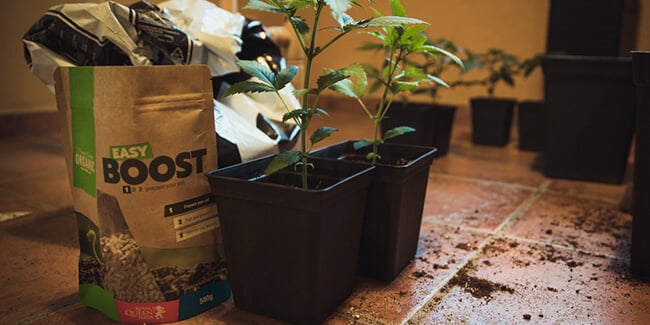Growing Organic Cannabis Outdoors
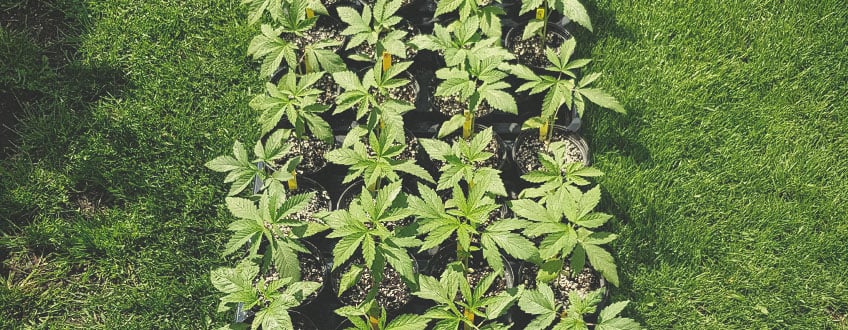
Contents:
- Why grow cannabis organically?
- Choose the best spot for your organic outdoor cannabis grow
- Plant in pots or in the ground?
- What kind of soil to use when growing cannabis outdoors?
- Optimising outdoor soil
- Creating your own super soil mixes
- Nutrients cannabis needs to flourish outdoors
- Beneficial organic soil amendments
- More tips for a successful organic outdoor cannabis grow
- How to care for soil during winter in 5 steps
After the harrowing months of winter when the days finally get longer again and the first whispers of warmth can be felt, excitement is in the air. Spring has finally come; and with it, the outdoor cannabis season!
But don’t get your seeds out just yet, as we don’t want to rush into things. We want to prepare our outdoor cannabis garden optimally so we can look forward to healthy plants and great crops of juicy and aromatic buds.
Why Grow Cannabis Organically?
For our outdoor cannabis grow, we’re choosing a natural and organic route. The reason is simple: Many connoisseurs consider the final results from an organic garden more satisfactory. Your weed will be tastier, more aromatic, and will be oozing with resin!
Moreover, a well-prepared organic grow will improve the resistance of your plants against the elements and pests, which is hugely beneficial when growing outdoors.
And, last but not least, organic and sustainable gardening practices cause no harm to the Earth or its inhabitants. And what could be better than growing great cannabis and doing something for the environment at the same time?
So, let’s get started with preparing our organic garden for a great outdoor grow!
Choose the Best Spot for Your Organic Outdoor Cannabis Grow
If you don’t have a dedicated space in your garden yet, the first step will be to find a good spot for your weed to grow. Cannabis loves light, and lots of it. Ideally, you want the location to be facing south. The optimal scenario is when your plants can access plenty of direct sun during the day, and then some filtered/diffused light later in the afternoon and evening.
Other important considerations for a good growing spot include:
-
Protection From the Elements
Make sure your cannabis isn’t exposed to severe wind and weather. A nice spot behind a shed or near a fence can provide protection from high winds and strong rainfall. Alternatively, plant in pots to give you the option of moving your cannabis to safety should bad weather strike.
-
Privacy/Stealth
You may want to keep your plants out of sight from nosey neighbours and passersby. After all, you wouldn’t want to go through all that effort just to have your weed stolen, would you? Check out some other useful tips on stealth growing to really keep things under wraps.
-
Accessibility
Accessibility is another concern, especially if you’re growing out in the wild. It won’t be practical to plant somewhere that's far away or extremely hard to get to. Remember, your plants will need watering and sufficient care from time to time, even if you’re doing a guerrilla grow in the wild. This spot should not be too difficult to reach, but also somewhat far away from places where other people may stroll around.
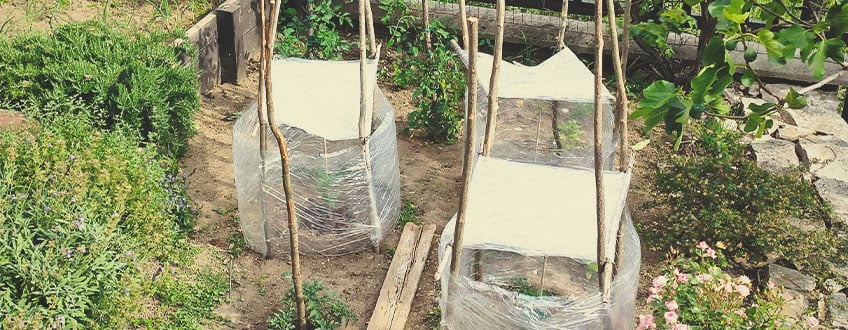
Plant in Pots or in the Ground?
If you’re growing cannabis outdoors, you have a few different options. First, you can grow in a clandestine location away from your house using natural soil, or you can bring cannabis-specific soil to said location to boost its quality. Simply dig a hole and fill in the good soil. You can recognise poor natural soils by their sandy and bright appearance.
You also have the option of growing in pots. This comes with a few advantages, the most obvious being portability. For example, it allows you to bring your plants to safety before a storm. Or, maybe it turns out the guerrilla grow spot you’ve chosen is a little too well-tread for your liking. No problem! Just move your plant a little further afield.
Disadvantages of growing in pots? Your plants may not reach their full potential due to size limitations. On the other hand, if you choose large-enough planters, you can still grow monster specimens. In our opinion, the pros of pots outweigh the cons.
If you have garden beds at your disposal, you can plant your weed directly in the ground, right at home. This, of course, is assuming it's safe to do so. If you can, though, your plants will really be able to expand their root system and deliver massive hauls.
What Kind of Soil to Use When Growing Cannabis Outdoors?
When growing cannabis outdoors, healthy soil is one of the most important factors to your crop’s success. Well-prepared organic soil promotes expansive root growth and lush and vibrant vegetation. Good soil also makes plants less prone to pests and disease, which is a big plus when growing outdoors.
Know Your Soil
Cannabis doesn’t grow equally well in all soils. Some soils are better suited for flowers or for vegetables, so you’ll want to know what exactly you’re dealing with. Become acquainted with the texture, composition, compactness, and drainage associated with good soil. Good soil for cannabis is typically dark and rich, but not too compact. It should have good water retention and drainage at the same time, and it should be rich in the right types of nutrients. Moreover, the pH value should be between 6–7.
- Pro tip: If you’re not intent on growing 100% organically, you can use commercial soil that’s made for growing cannabis. Soil from a reputable brand usually has the optimal composition, texture, and pH to bring your plants to a successful harvest. Most of the time, ready-made soils are pre-fertilised with nutrients for the first 3–4 weeks of growth.
But when growing organically, where you’ll amend soil with compost, worm castings, and other organic matter, microorganisms will turn the matter into nutrients for your plants. Nature will take care of everything—you won’t even need to administer extra nutrients!
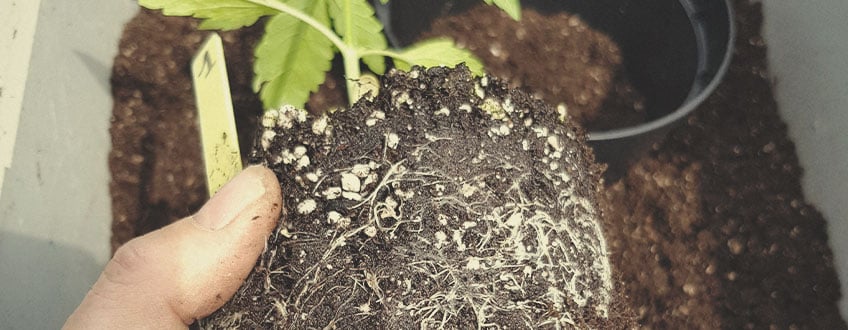
Use the Right Soil for Feminized vs Autoflowering Cannabis
Feminized (aka photoperiod) cannabis and autoflowers grow somewhat differently. Autoflowers are usually much smaller, but grow and flower faster. Because they bloom automatically after a few weeks, they are less forgiving of major mistakes.
For that reason, you want to make it easier for your autoflowers to grow. The best soil for autoflowers is airy and well-draining—even more so than the soil used for feminized cannabis. Though you’ll still want it to be rich and dark, you’ll want to avoid overly fertilised soils that may burn your auto plants.
- Pro tip: Add 10–15% perlite to make the soil lighter and improve drainage.
Optimising Outdoor Soil
There are numerous ways you can optimise your outdoor soil to support healthy and robust growth, regardless of how exactly you choose to grow.
-
Silica Supplements
Silicon is the most abundant element in the ground. Plants love it and will reward you with healthy growth if they have easy access. Adding silica supplements offers a multitude of benefits:
- Improves nutrient uptake
- Promotes faster growth
- Protects plants from metal toxicities
- Increases resistance and strengthens plant tissue
- Increases resilience to pests and disease
-
Perlite
Perlite is a heat-treated mineral that’s great for improving soil quality. The white, light rocks make the soil airier and improve drainage. Perlite also has minor water-retention abilities. Add about 10–15% perlite to your soil.
-
Water-Absorbent Polymers
These come in the form of small jelly balls that you add to the soil, and they do exactly what their name suggests. These gels can absorb, hold, and store water. Water-absorbent polymers are ideal for outdoor growing, especially if you grow in the wild and can’t visit your plants frequently. With these, your plants can endure even long dry spells.
Creating Your Own Super Soil Mixes
Once you get a taste for organic growing, you may not want to go back to using mineral nutrients. More experienced outdoor farmers often make their own super soil mixes and soil amendments. Doing so has several advantages (and a few drawbacks/considerations):
Pros:
- Homemade super soil is rich in nutrients, so you’ll be less reliant on chemical fertilisers.
- You’re in control of where your plants get their nutrients from.
- No harsh chemicals means more natural flavour from your buds and a smoother, tastier smoke.
- It’s sustainable and environmentally friendly.
- It saves money in the long-run.
- You'll feel a sense of achievement from creating your own substrate.
Cons:
- The process takes time and some effort.
- Super soils cost more outright than buying a bag of ready-made soil.
Perfect your outdoor soil: Download our beginner's guide to cannabis growing today!
Free RQS
Grow Guide!

Nutrients Cannabis Needs to Flourish Outdoors
Along with good soil, plenty of sun, oxygen, and some loving care, your cannabis will require nutrients to grow. What actually are these nutrients, and how can your cannabis plants access them?
-
Macronutrients
Nutrients for cannabis are separated into so-called macronutrients and micronutrients. The macronutrients include the three main nutrients—nitrogen (N), phosphorus (P), and potassium (K)—as well as secondary nutrients calcium (Ca), magnesium (Mg), and sulphur (S). These are classed “macro” nutrients because they’re essential for the growth of your cannabis in relatively large quantities.
-
Micronutrients
There are also micronutrients, such as zinc (Zn), iron (Fe), and copper (Cu), along with a whole bunch more. These trace elements are also important for your cannabis to stay healthy, but plants require less of these compared to the macronutrients.
Good organic soils will contain both macro- and micronutrients so your cannabis can grow healthy and productive.
-
Microorganisms: The Key to Organic Growing
When growing organically, the goal isn’t to directly supply your cannabis with nutrients, as you do when growing with conventional mineral nutrients. Instead, what you do is create the perfect environment for microorganisms in the soil. The soil microorganisms turn organic matter into nutrients just as it happens in nature –– no chemicals needed! The microorganisms and their well-being are therefore key in organic gardening
Beneficial Organic Soil Amendments
To turn your soil into an organic environment where beneficial microorganisms will thrive, you can add the following:
-
Worm Castings
Yes, worm poop! Amending soil with worm castings is one of the oldest and most effective organic farming methods. You don’t need your own worm farm to get worm castings (although you could), as they are also available from gardening shops and grow shops.
-
Bokashi
Bokashi is a Japanese composting method that uses beneficial microorganisms to ferment food waste and turn it into an environmentally friendly fertiliser. Some consider it even better than regular compost as it contains more nitrogen. What’s more, compared to regular composting, bokashi takes a lot less time and uses less space. It’s sort of like mini composting, and, of course, it’s perfect for growing cannabis!
-
Mycorrhizal Fungi
Mycorrhizal fungi are a type of beneficial fungi that enter a symbiotic relationship with your cannabis plants. Working together with the roots, these fungi increase nutrient uptake and benefit plant health in many other ways. You only need to add mycorrhizal fungi once to your soil for your cannabis to reap their benefits throughout all stages of its life.
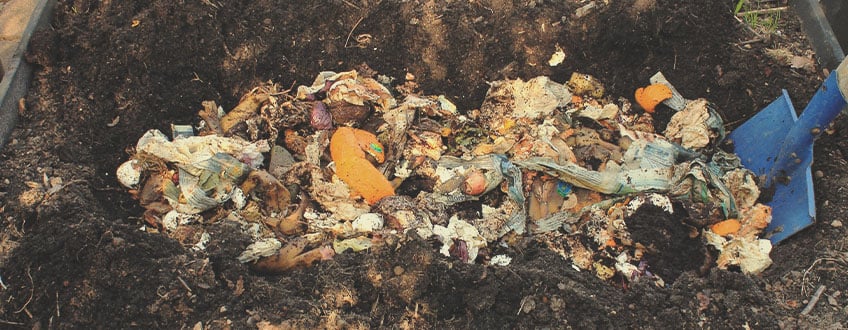
-
Nematodes
Nematodes are another kind of tiny critter that provide a big benefit for your plants. They are the enemies of some common cannabis pests, such as fungus gnats, caterpillars, fly larvae, and a whole lot more. Nematodes, along with beneficial insects such as ladybugs, are an effective form of biological warfare for organic growing!
-
Enzymes
In nature, beneficial microorganisms in the soil secrete enzymes to help them break down large molecules faster and more efficiently. By adding enzymes to the soil, you make it easier for these helpful guys to break down organic matter that they will turn into nutrients.
Check out more information on organic super soil amendments, from bat guano and chicken manure to bone meal and kelp meal.
More Tips for a Successful Organic Outdoor Cannabis Grow
Along with a good location and good soil, there are more things you can consider when preparing to grow organically outdoors.
Use Companion Plants
Companion plants are species that you grow alongside your weed. They can provide you and your plants with several benefits:
- Large companion plants, such as stinging nettle or beans, are great for camouflaging your weed.
- They can provide natural protection from wind and weather.
- Some companion plants, like garlic or peppermint, are natural insect repellents.
- The strong scents of some companion plants can mask the smell of your cannabis.
- Certain companion plants can improve soil conditions for cannabis.
ROLS & No-Till Farming
ROLS is short for recycled organic living soil. It means that you’re constantly adding organic matter to the soil, just as happens in nature. By returning nutrients and vitality to the soil, the ROLS system ensures the topsoil remains healthy and produces top-quality crops. ROLS is one of the schools of thought of modern organic farming, along with the no-till method.
Unlike conventional farming, no-till is a method where the soil isn’t disturbed by digging, tilling, stirring, etc. The idea is to allow the undisturbed soil to become a living ecosystem that replenishes itself through a combination of beneficial bacteria, helpful fungi, and other living organisms.
Benefits of these methods:
- Improves biological activity in soil and increases organic matter.
- Minimises soil erosion and water evaporation.
- Supports healthy organic soil biology as intended by nature.
- Soil can be reused for many years.
Tips for Reusing Old Soil
Speaking of reusing soil, all you need to do to prepare it is sterilise it of harmful bacteria and fungi. Once your old soil is clean, you can revitalise it with fresh organic amendments like compost, bat guano, worm castings, blood meal, etc. Improve the structure of your soil by adding some perlite, sand, and vermiculite.
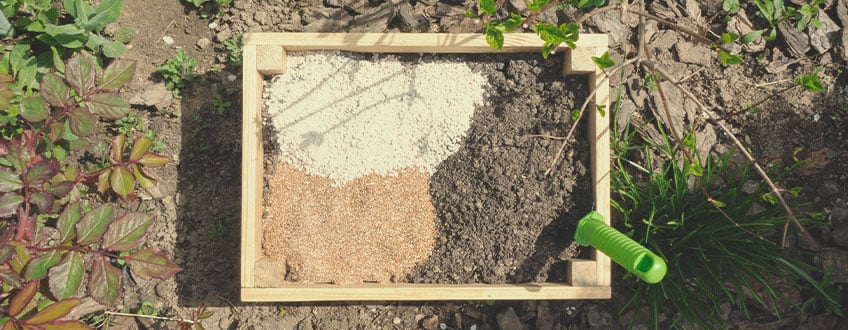
Mulch: Why Your Organic Garden Loves It
Mulching your soil provides similar benefits as adding compost, although mulching comes with its own advantages. Mulch is rich in nutrients and also acts as a natural barrier for slugs and snails, as they are not much interested in it. Underneath the protective layer of mulch, the soil will keep moist and well-aerated at all times.
To get ready for planting in spring, a good way to go about mulching is to do it in autumn, preferably some time after harvest. During the following winter months, the organic matter in the mulch will break down and enrich the soil with nutrients and beneficial microorganisms. Come spring, you will have the perfect environment for your organic cannabis grow!
Benefits of mulching:
- Reduces soil erosion and compaction
- Maintains optimal soil temperatures
- Enriches soil with nutrients
- Improves soil water regime
- Decreases risk of pests and disease
- Helps reduce salt buildup in the soil
- Promotes strong root growth
- Improves overall plant vigour and resistance
How to Care for Soil During Winter in 5 Steps
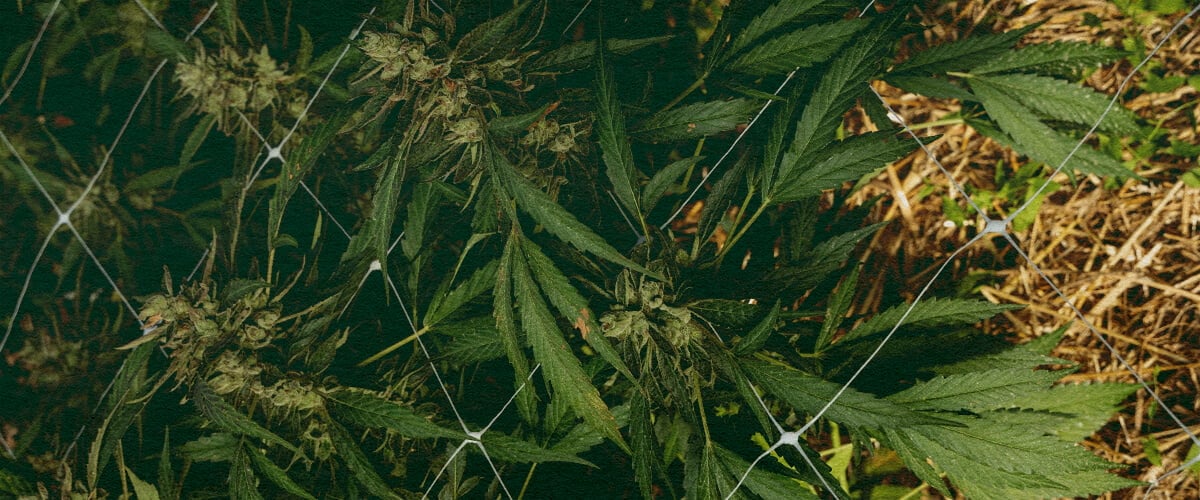
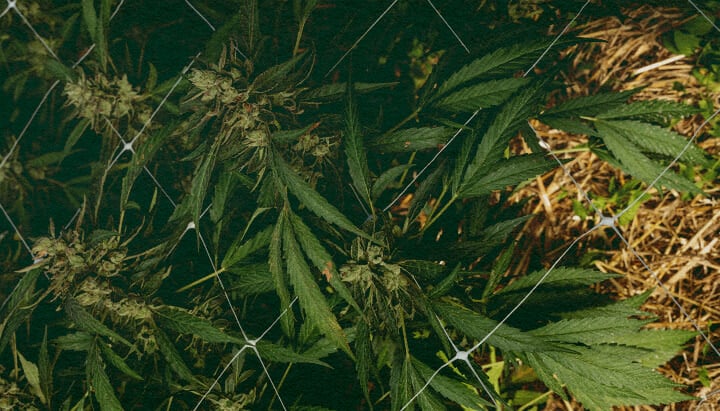
In the winter when temperatures drop to or below 7°C, biological activity in the soil comes to a halt. For that reason, the idea that soil can improve in the cold months seems contradictory. However, it can be done if you know how:
-
Use Mulch
Outdoors in autumn, some of the best mulch is readily available in the form of fallen leaves. But don’t just use leaves; add in some other organic material like wood chips to keep your soil healthy.
-
Don’t Disturb the Soil
At the end of the season, the used soil at your location will contain all kinds of fresh organic materials, such as roots and fungi. At this point, these materials are not too useful yet, as they still need to rot during the following months. For that reason, it is best if you don’t touch the soil and just allow Mother Nature to do her thing. Come spring, all that stuff in the soil will be put to good use! Disturbing the soil will prevent or slow down what will come naturally.
-
Grow Winter Greens
Cold-hardy plants such as legumes, certain kinds of grasses, or flowers can protect the soil from erosion in winter. As an added benefit, when planting cold-hardy plants such as winter beans, these will develop big root systems that will improve the soil and increase organic matter content. When you cut them in spring, some plants, such as winter peas, will also leave nitrogen reservoirs in the soil—perfect for planting your cannabis!
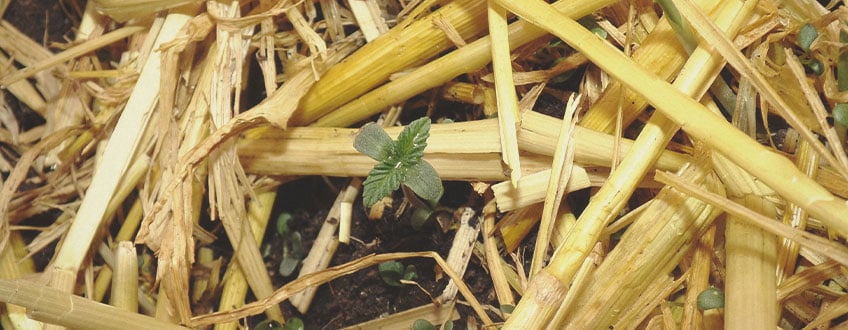
-
Leave Your Winter Weeds
While you don’t want weeds taking over your growing spot in summer, it’s a different story in the winter. First, winter weeds are usually less invasive, not that it would matter much as you already harvested your cannabis. Some varieties, like chickweed, protect the soil from erosion. Others, among them dandelions and cress, can greatly improve soil texture and drainage with their large roots. Once the growing season starts off in spring, just cut them and add them to your compost.
-
Cover Your Garden With Compost
Similar to adding a protective layer of mulch, you can achieve the same thing by covering your gardening spot with compost! Just add an old rug or blanket over top to keep the right amount of insulation while allowing moisture to reach down into the soil. Cosy temperatures under this cover will then result in a rich soil come spring. All you need to do is remove the blanket, give it a couple days to breathe, and you’re all set for your springtime cannabis grow!
Categories
Nutrients and boosters


























